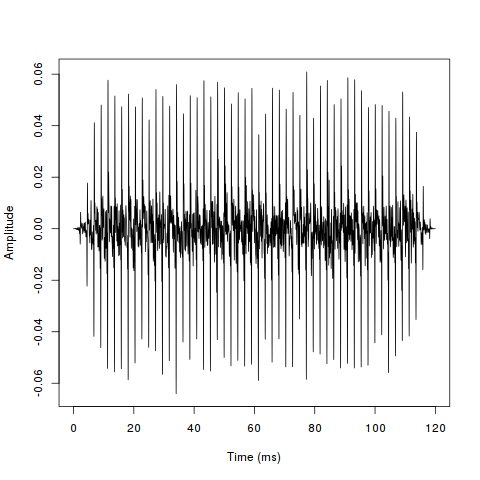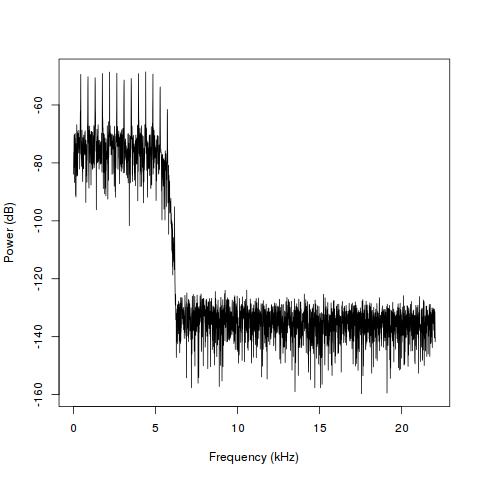This page describes some basic sound processing functions in R. We’ll use the tuneR package to read in wav files. No other packages will be needed for this tutorial, however, there is a number of packages that are in general very useful for working with sound in R:
- signal – MATLAB like signal processing functions
- seewave – functions for analysing, manipulating, displaying, editing and synthesizing time waves (particularly sound).
We can install the sound package with
install.packages('tuneR', dep=TRUE)
Assuming that the tuneR package has already been installed correctly we can load it with the library() function
library(tuneR)
Now we can read in a wav file, you can download it here 440_sine.wav, it contains a complex tone with a 440 Hz fundamental frequency (F0) plus noise.
sndObj <- readWave('440_sine.wav')
sndObj is an object of class Wave, we can inspect its properties with the following command:
> str(sndObj)
Formal class 'Wave' [package "tuneR"] with 5 slots
..@ left : int [1:5292] 0 0 0 0 0 0 0 0 0 0 ...
..@ right : int [1:5292] 0 0 0 0 0 0 0 0 0 0 ...
..@ stereo : logi TRUE
..@ samp.rate: int 44100
..@ bit : int 16
the wav file has two channels (@left and @right) containing 5060 sample points each, considering the sample rate ([email protected] = 44110) this corresponds to a duration of 120 ms:
> 5292 / [email protected]
[1] 0.12
we’ll select and work only with one of the channels from now onwards:
s1 <- sndObj@left
the readWave function reads wav files as integer types. Our wav file has a 16-bit depth (sndObj@bit), this means that the sound pressure values are mapped to integer values that can range from -2^15 to (2^15)-1. We can convert our sound array to floating point values ranging from -1 to 1 as follows:
s1 <- s1 / 2^(sndObj@bit -1)
Plotting the Tone
A time representation of the sound can be obtained by plotting the pressure values against the time axis. However we need to create an array containing the time points first:
timeArray <- (0:(5292-1)) / [email protected]
timeArray <- timeArray * 1000 #scale to milliseconds
now we can plot the tone:
plot(timeArray, s1, type='l', col='black', xlab='Time (ms)', ylab='Amplitude')

Plotting the Frequency Content
Another useful graphical representation is that of the frequency content, or spectrum of the tone. We can obtain the frequency spectrum of the sound using the fft function, that implements a Fast Fourier Transform algorithm. We’ll follow closely the technical document available here to obtain the power spectrum of our sound.
n <- length(s1)
p <- fft(s1)
the fft is computed on the number of points of the signal n. Since we’re not using a power of two the computation will be a bit slower, but for signals of this duration this is negligible.
nUniquePts <- ceiling((n+1)/2)
p <- p[1:nUniquePts] #select just the first half since the second half
# is a mirror image of the first
p <- abs(p) #take the absolute value, or the magnitude
the fourier transform of the tone returned by the fft function contains both magnitude and phase information and is given in a complex representation (i.e. returns complex numbers). By taking the absolute value of the fourier transform we get the information about the magnitude of the frequency components.
p <- p / n #scale by the number of points so that
# the magnitude does not depend on the length
# of the signal or on its sampling frequency
p <- p^2 # square it to get the power
# multiply by two (see technical document for details)
# odd nfft excludes Nyquist point
if (n %% 2 > 0){
p[2:length(p)] <- p[2:length(p)]*2 # we've got odd number of points fft
} else {
p[2: (length(p) -1)] <- p[2: (length(p) -1)]*2 # we've got even number of points fft
}
freqArray <- (0:(nUniquePts-1)) * ([email protected] / n) # create the frequency array
plot(freqArray/1000, 10*log10(p), type='l', col='black', xlab='Frequency (kHz)', ylab='Power (dB)')
The resulting plot can bee seen below, notice that we’re plotting the power in decibels by taking 10*log10(p), we’re also scaling the frequency array to kilohertz by dividing it by 1000

To confirm that the value we have computed is indeed the power of the signal, we’ll also compute the root mean square (rms) of the signal. Loosely speaking the rms can be seen as a measure of the amplitude of a waveform. If you just took the average amplitude of a sinusoidal signal oscillating around zero, it would be zero since the negative parts would cancel out the positive parts. To get around this problem you can square the amplitude values before averaging, and then take the square root (notice that squaring also gives more weight to the extreme amplitude values):
> rms_val <- sqrt(mean(s1^2))
> rms_val
[1] 0.01382841
since the rms is equal to the square root of the overall power of the signal, summing the power values calculated previously with the fft over all frequencies and taking the square root of this sum should give a very similar value
> sqrt(sum(p))
[1] 0.01382841
References
- Hartmann, W. M. (1997), Signals, Sound, and Sensation. New York: AIP Press
- Plack, C.J. (2005). The Sense of Hearing. New Jersey: Lawrence Erlbaum Associates.
- The MathWorks support. Technical notes 1702, available: https://web.archive.org/web/20120615002031/http://www.mathworks.com/support/tech-notes/1700/1702.html
Hello Sam,
I find your article very informative. However I am unclear at the point above the “plotting the tone” paragraph. Could you explain what kind of variable “snd” is?
Thanks,
Vivek
Hi Vivek,
actually that was a typo, rather than “snd” it should have been “s1”. The typo has now been fixed.
Cheers,
Sam
Hey Sam,
Great post. Say I want to change the dB reference pressure in the power spectrum. What would be the best way to do this?
Thanks
Sean
In the examples above the reference pressure is implicitly 1. Let’s say that your reference pressure is
refPress, your reference power will berefPow = refPress^2, then to change the reference pressure in the power spectrum you would use:Hi
Actually I read about scipy.io.wave.read() function and was unclear about whether the array(snd in your case) is amplitude or sound pressure level.
Because for it to be amplitude or sound pressure level it should have a unit.
Your help will be appreciated.
Thanks
the
sndarray in the Python tutorial represents the amplitude (not the level) of the waveform. The unit of measurement is arbitrary. If you play out the WAV file the actual RMS level will depend on your equipment (soundcard, volume settings on your computer, speakers/headphones, etc…), so there is little point trying to attach an absolute measurement unit to the amplitude values of the waveform. If you calibrate your equipment (for example, using a SPL meter) you can map the amplitude values of the waveforms to a given output level of your equipment. Hope that helps!Hi
First of all thanks for clearing that out.
Also,
In your code, you mention the array as having pressure values and while plotting you call it amplitude. Are they interchangeable? The two quantities- Pressure values and Amplitude are completely different.
One more thing is there any method to get the array of Sound Pressure Level(dB).
Thanks
Sorry, I’m not a physicist or an engineer and I’m probably being sloppy with terminology. Amplitude is the change in atmospheric pressure caused by the sound wave:
http://www.indiana.edu/~emusic/acoustics/amplitude.htm
what you get in the
sndarray are the instantaneous amplitude values of the waveform (in arbitrary units). If you want the instantaneous intensity values (again in arbitrary units), just square the amplitude values. If you want the instantaneous level values in dB you take 20log10(p) which is equivalent to 10log10(I), wherepis instantaneous pressure andIis instantaneous intensity. Note that these levels are in dB, but not in dB SPL because they are in arbitrary units (see my previous comment). Knowing the instantaneous levels is generally not very useful, if you want to get an idea of the loudness of a sound you should measure its RMS level over a period of time. Can I ask why you want to know the SPL? Are you trying to solve a specific problem, or just want to know more about sounds? There are lots of good tutorials on sound that explain these concepts, this one is pretty good:http://clas.mq.edu.au/speech/acoustics/basic_acoustics/basic_acoustics.html
It may also be good to get a textbook if you want to know more. Hartmann’s book, Signals, Sound, and Sensation, which is cited in my blog post is a great reference.